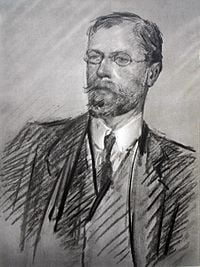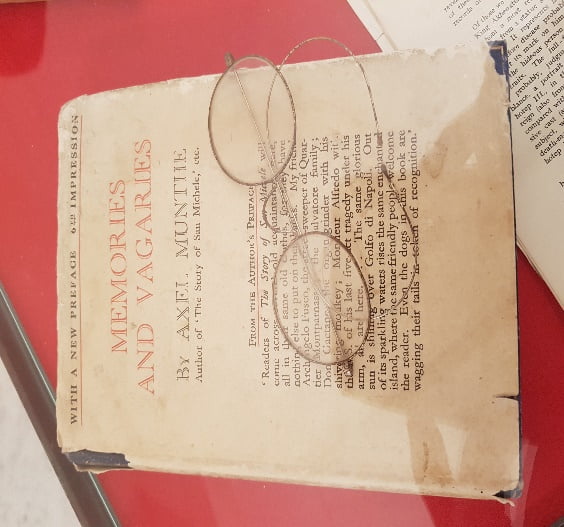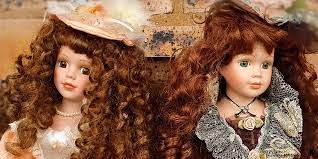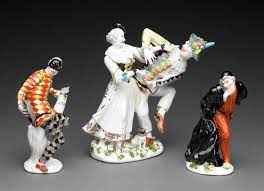Conversation 23: Axel Munthe: the treatment using dolls for the daughter of the aristocracy
Greetings

Axel [Martin Frederik] Munthe (1857 – 1949)
In Wikipedia and in a contemporary exhibition [February March, 2023] in honor of his archaeological activity at the Historical Museum of Archeology in Naples Italy it is stated that Axel [Martin Frederik] Munthe (1857 – 1949) was a Swedish physician and psychiatrist, the author of the book "The Story of San Michele", a book describing his life and work . Munthe grew up in Sweden, studied medicine there, and later studied medicine in Paris (where he was a student of Charcot with whom he had a conflict).
Munthe opened his first clinic in France but spent most of his adult life in Italy at his home on the island of Capri known as San Michele.

Villa San Michele on the island of Capri


Axel Munthe . The story of San Michele. 1929
As mentioned, after finishing his studies, Munthe opened a clinic in Paris, mainly to serve the members of the Scandinavian art colony there. In 1884 he traveled to Naples to offer medical aid during a cholera epidemic. In 1887 he moved to Capri, bought the Villa San Michele and began its restoration, in 1890, when the money for restoration began to run out, he opened a clinic in Rome and from that point on divided his time between Rome and Capri. During the First World War he volunteered for the Red Cross and cared for the war wounded
Apparently he had a complex personality, one that could connect with the aristocracy [he treated royals from Sweden and England] on the one hand and the common man on the other. We note that there are some critics who tend to attribute exaggerations to some of his writings, especially in his book "The Story of San Michele".
Munthe tried to avoid giving medication as much as possible, especially in his psychological therapeutic cases, and often recommended hypnosis, music, walking, sailing and a variety of other alternative medical approaches.
Below we will bring you a therapeutic case from his writings. We will analyze it later according to our assumption that the "SOCIAL SELF" of the person, which includes its perceptions, actions and views, consists of a "board" of internalized figures, while the person itself is not aware of this.
This therapeutic case [which one of us [J.L.] freely translated in a way that conveys the spirit of things] is from Axel Munthe's introduction to the book that appears on the Gutenberg website [https://www.gutenberg.org] under the name "Memories and Vagaries" and in a free translation "Unexpected and unexplained memories and changes."

And so Axel Munthe writes in his introduction to this book:
"Now I want to tell you what made me publish this book – on the other hand, what made me write the book cannot necessarily be of interest. One day I found myself sitting in my consulting room with a young lady who had a huge package on her lap. I asked her what I can do for her, and she began to tell me quite a long story about herself. She said that nothing in the world interested her, nothing amused her, she was bored to death by everything and everyone. She could have everything she wanted, she could, have everything, she could go anywhere she wanted, but she didn't want anything, she didn't want to go anywhere [By the way, read my article on this website about the story of Ze'ev Herzl, the founder of the Jewish state known as "The healing from the black bile", which reports on a man who suffered from a similar situation who had everything and nothing interested him.]
Her life was spent in idle luxury, useless to herself and everyone around her. Her parents finally dragged her from one doctor to another: one prescribed a trip to Egypt, where they spent the whole winter; Another one talked her into a trip to Cannes, where they bought a large villa; India was the third followed by Japan, which they visited on their fine yacht. "But you are the only doctor who has done me good," she said to Axel Munthe. "I've felt more happiness in the last week than anythingvisit I've done in years. I owe it to you, and I've come to thank you for that." She quickly began unwrapping her package, and I [Dr. Axel Munthe] stared at her in astonishment as she took out large dolls one by one, and placed them in a row on my desk among all my rabbinic books and essays. There were twelve dolls in all, and you never saw dolls like them. Some were dressed in tailored jackets and skirts; some of them were apparently seen going on a yacht trip in blue serge suits and sailor hats; some wore elegant silk dresses covered with lace, frills, and hats decorated with huge ostrich feathers; And some of them looked as if they had only just returned from the queen's visit.
I'm used to, writes Munthe, that there are queer people in my consulting room, and I remember noticing something sparkling in her eyes. "You see, Doctor," she said aloud, "I never thought I could be like that, a favor to anyone. I used to send money to charities from my house, but all I did was write a check, and I can't say I ever felt any satisfaction in doing that. A few days ago I chanced upon an article about toys in an old Blackwood magazine and since then I have been working from morning till night to dress up all those dolls for the poor poor children you spoke of and hinted to me about. I did everything by myself, and in a strange way I felt so happy all this time." And I, (Dr. Munthe), experiencing for a moment this little escape from the hustle and bustle of everyday life, looked at her sweet face smiling through tears, and looked at the long line of dolls who looked at me with happiness among all of my medical equipment that was lying on the desk. And I [as a man and a doctor] felt for the first and last time in my life the unbearable joy of a sense of victory, and for the first and last time in my life I felt this mystic working within me and my power of being able to move others.
A decorated carriage was waiting for her at the door, but we sent it away, and I put this generous benefactor and some of her dolls into the cab, and I remember we went to see Petruchio the common man and his poor children. I could tell by her shyness that this was the first time she had entered the home of the poor. She gave each child a magnificent doll, and blushed with pleasure when she saw the radiant faces of the little girl and her sisters and we heard the voice of the poor, poor mother saying to her "God, God bless you!". Hardly a week passed before she brought me another dozen dolls, and twelve more sick and destitute children forgot all about misery. At Christmas I had a big celebration in the Jardin des Plantes, a quarter where the poor Italians live, and the Christmas tree was loaded with her dolls of all sizes and fancy clothes. She kept bringing me more and more dolls, until a time came when I didn't know what to do with them, as I had more dolls than patients. All the chairs and tables in my room were occupied by dolls, and people asked me to show them my "dear children", and when I told them I was still single at the time they did not believe me. To tell you the truth, when spring came I sent the lady to St. Moritz for a change of air. I have never seen her ever since…
In an article for Prof. Joseph Levine's personal blog, it is written about this case that "It is interesting that many studies in the science of happiness show that giving and compassion to others contribute to the happiness of the donor to others. In this case of hers, giving purely a check without any emotional involvement was not effective, though giving with commitment and with self-investment, personal acceptance of the thanks and appreciation of the donors gave a new meaning to her life…..in addition, it may also be important that although the therapist guided her suggestively [apparently] in this direction of active giving to the children of the poor, but actually she herself found the way to it, That is, finding the particular way [dressing and giving the dolls] came from her.
We here [Dr. Salganik and Prof. Levine] believe that the case can indeed be interpreted on the one hand according to Sigmund Freud and his successors, relying on the theory of psychoanalysis [it seems that Freud would have interpreted almost certainly that she suffered from a conflict regarding the desire to express sexual urges on the one hand and the prohibitions of the norms of the period and the aristocracy on the other hand, that she developed an erotic attraction towards Munthe and these dolls were a symbolic sexual expression of their connection. It is possible that he would have even hinted that Munthe himself developed an erotic attraction to her and the hint of this is his feelings of transcendence following his meetings with her and he would certainly have also expanded on the issue of transference in this treatment [see below the definition of the concept of "transference"] and implies that Munthe had difficulty in resisting his urges so that he sent her away from him to St. Moritz].


But we choose to interpret this case according to the theory of internalized characters which is the subject of this blog.
First, we note that the period of treatment seems to have been in the second half of the 19th century as it is mentioned in the case description that Munthe was single at that time, while he married in 1880 Ultima Hornberg whom he met while studying in Paris and from whom he divorced during the 1980s.
Secondly, we note that in a conversation with CHAT GPT, the artificial intelligence software, it states from its sources that porcelain dolls were very popular in the 19th century, especially among the upper classes. They were often made in Germany and France, with the German city of Dresden being particularly famous for its porcelain doll production. These dolls were made of a type of porcelain called bisque, which is unglazed and has a matte finish. The bisque is often dyed to create a more realistic skin tone for the dolls. The dolls were usually attached at the shoulders, hips and knees, which allowed them to be placed in a variety of poses. The clothes and accessories for porcelain dolls were often made of fine fabrics and cuts, paying attention to every detail. The dolls were often dressed in the latest fashions, reflecting the styles of the day. Porcelain dolls were considered a luxury item and were often collected and displayed in the homes of wealthy families. They were also popular as gifts, especially for young girls. Today, antique porcelain dolls from the 19th century are highly sought after by collectors. Their subtle beauty and historical significance make them a valuable and expensive part of many collections. To our surprise, it seems that GPT CHAT simply took an entire section from Maria Teresa Hart's article that we will quote below, without indicating the source, and contrary to our prior assumption that GPT CHAT integrates several sources or many sources.
And so the writer and editor Maria Teresa Hart writes in connection with this in 2022 in the Smithsonian magazine: Dolls and especially [but not only] porcelain dolls were common and very popular in the 19th century, especially among the upper classes. The German city of Dresden was especially known for the production of its porcelain dolls. These dolls were made of a type of porcelain called bisque. The bisque is often dyed to create a more realistic skin tone for the dolls. The dolls were usually joined by movable joints at the shoulders, hips and knees, which allowed them to be placed in a variety of poses. The clothes and accessories for porcelain dolls were often made of fine fabrics and cuts, paying attention to every detail. The dolls were often dressed in the latest fashions, reflecting the styles of the time. Porcelain dolls were considered a luxury item and were often collected and displayed in the homes of wealthy families. They were also popular as gifts…(greetings to CHAT GPT). By the way, Maria Theresa Hart also adds and writes that these dolls had a fashionist forerunner: the French royal court would send the doll figurines fully decorated in the latest styles so that the aristocracy in other countries could copy them for their display cabinets. It was actually the 18th century version of flipping through Vogue…
Dr. Igor Selgnik adds and points out that from reading the writings of the period he understands that all dealing with dolls in that period was also common to a certain extent among adults and to a certain extent these sometimes represented the social perception of the practitioner. He states that he knows from his studies in Germany about the porcelain dolls of the German company Meissen, a very old company that already existed in the 19th century and exists up to this day, which is famous for the production of its exquisite porcelain dolls. Although, he adds, today it is no longer common to keep porcelain dolls in the house, but back then every house, and noble houses had dolls [made of porcelain, clay and other materials about scenes from life, for example hunting, etc.] and statues with symbolic meanings, some from Greek, Roman myths, etc. '. The dolls and statues usually reflected the world of the aristocratic families.

Porcelain dolls made by Meissen manufacture.
By the way, we also note that the use of dolls and the concept of a status symbol embodied in porcelain dolls was not new. The connection between dolls and status symbols was also created in the more distant past. In the Middle Ages, the property of the masses on the one hand were clay dolls that were easy to make and were widely available – while decorated knight dolls with accessories were rare and refined items that were reserved for the children of the upper classes and royalty. The use of the doll as a status symbol even goes back to ancient times. Such is the case of Carparia Trypana, a Roman woman whose sarcophagus contained a beautifully sculpted doll in her likeness. Death is the great destroyer: all skeletons look the same and they decay. But this doll served as a kind of testimony to the body of its owner. When Trypana's physical presence could no longer communicate her status, the doll's sculpted face, styled hair and small details succeeded in conveying the message.
And finally we note that such Victorian dolls, which were created mainly for rich children, embodied the great division and gap between the children of the rich and the upper classes and the children of the lower and simple class and reflected it in a clear and concrete manner where the former cultivated rituals of consumption and display of these magnificent porcelain bisque dolls, depicting high society dressed in velvet and lace clothing.
Thirdly, we note that in the 20th century, mental therapy for children using dolls was developed including the one from the seminary of the psychoanalyst Melanie Klein and her successors. Melanie Klein was a pioneering psychoanalyst known for her work in object relations theory, which emphasizes the importance of early childhood experiences and relationships with caregivers in shaping personality development. In the later years of her career, Klein also became interested in the therapeutic use of dolls, which became known as "doll therapy."

Melanie Klein, an Austrian Jewish psychotherapist and psychoanalyst [1882-1960].
According to Klein, this is how the artificial intelligence chat GPT summarizes from its sources [see below] in our additions, dolls can serve as powerful objects of transference and countertransference in psychotherapy [transference, we note, is a phenomenon characterized by the unconscious transfer of emotions from one person to another. Within a therapeutic relationship, this is expressed in the release of a repressed emotional relationship that the patient felt towards a significant person in his past to the therapist. Countertransference, on the other hand, is the therapist's emotional response to the transference expressed by the patient towards him]. By projecting their thoughts, feelings and experiences onto the doll, patients can work through a range of unconscious conflicts and emotions in a safe and non-threatening manner.
Doll therapy can be especially helpful for patients who experienced early disruptions in attachment to a significant figure in infancy as it provides a way to recreate and re-experience early patterns and relationships in a contained and controlled environment.
Klein believed that the therapeutic use of dolls could help patients gain a greater sense of self-awareness, emotional regulation, and interpersonal skills. However, it is important to note that doll therapy is not a panacea and may not be suitable for all patients or therapeutic contexts. In addition, there has been debate among psychoanalysts and other mental health professionals about the efficacy and ethical implications of doll therapy, particularly in cases where patients may become overly attached to their dolls or use them to avoid dealing with more difficult emotional material.
Klein, M. (1955). The Psychoanalysis of Children. The Hogarth Press and the Institute of Psychoanalysis/.
Klein, M. (1932). The Psychoanalysis of Children's Play. International Journal of Psycho-Analysis, 13, 403-414.
Axline, V. M. (1947). Play Therapy: The Inner Dynamics of Childhood. Houghton Mifflin.
Leuzinger-Bohleber, M., & Fischmann, T. (2019). Psychoanalytic Play Therapy: From Klein to Kohut. Routledge.
Oaklander, V. (1988). Windows to Our Children: A Gestalt Therapy Approach to Children and Adolescents. Gestalt Journal Press
It is interesting that it is also possible to develop [in the framework of our perception of the social self as consisting of internalized figures that are significant to the individual] treatment of dolls that can represent significant figures for the person. Here the patient can be asked to express the position of these characters when he speaks out loud when they are represented by and through the dolls and thus bring to his awareness their influence on him. Of course, the patient must first be explained that this is only a means and the dolls metaphorically represent the internalized characters.
By the way, while in the past doll therapy was traditionally used with children, today it is increasingly used with adults suffering from various kinds of dementia, such as Alzheimer's disease or other cognitive impairments. Here the purpose of doll therapy is to provide these people with a sense of purpose, meaning and mental relief. Many people with dementia experience feelings of confusion, anxiety and loneliness, and dolls can help alleviate these feelings by providing a sense of companionship and connection to the past. In some cases, dolls may also help trigger memories and encourage people to engage in social interactions.
After these three comments, we will come to the specific treatment and we will ask what happened to Axel Munthe, who states that such a thing has never happened to him before or since. It is evident that this was an intense and one-time experience for him. We assume that the change in the patient was not understandable to him, even while noting that this case led him to write a short book about "memories and unexpected and unexplained changes" hinting at that. From reading his statements, we surmise that he actually entered the patient's inner world and took responsibility for this world, while she entrusted her inner world represented by the dolls into his trusting hands. The note in the description that the dolls were everywhere in his rooms strengthens such a hypothesis. Our claim is that the patient introduced her inner world through the dolls into his world until his house was full of her dolls and unconsciously gave him the role and trust to take responsibility and control over her inner world.
If we remind us that according to our assumption the "social self" of each of us consists of a collection or a "directorate" of significant figures in our lives that we have internalized and among them a leader or leaders whose dominant one has the right of "veto" or censorship on the introduction of content and even characters to the "Directorate of Internalized Characters" a leader we called the "inner dictator" we could say that Munthe without him being aware of it became her inner dictator. That is to say, he was internalized into her social self and received a dominant position and this allowed a change in her attitudes towards life. As if all the internal conflicts in her world among the internalized characters in her “directorate” now were "on his desk" with him. It is possible that the fact that Munthe was benevolent with her as a therapist, allowing her to express herself, gave her the freedom to choose the path [making the dolls], transferring to him the responsibility for her, and giving him the role of being the director of her inner world, thus allowing her to bypass the prohibitions of the previous internal dictator [that ruled her before him] who apparently did not allow her to break through the norms of the aristocracy.
From this we claim that the main component of the change that took place in her may not have been the preparation of the dolls and their donation to the poor [although such preparation and giving has a certain contribution as well] but rather the giving of the dolls to Munthe, the charismatic therapist who received a special status in her inner world.
Cheers until the next conversation,
Dr. Igor Salganik and Prof. Joseph Levine
 Prof. Joseph Levine, M.D. is an emeritus associate professor in the Division of Psychiatry, Faculty of Health Sciences, Ben Gurion University in Israel. Prof. Levine is a certified psychiatrist with clinical experience in controlled trials of adult psychiatric disorders and in psychotherapy. He was awarded a NRSAD independent investigator grant for the study of Creatine Monohydrate in psychiatric disorders -- mainly Schizophrenia. He resides and treats patients in Tel Aviv and all of central Israel.
Prof. Joseph Levine, M.D. is an emeritus associate professor in the Division of Psychiatry, Faculty of Health Sciences, Ben Gurion University in Israel. Prof. Levine is a certified psychiatrist with clinical experience in controlled trials of adult psychiatric disorders and in psychotherapy. He was awarded a NRSAD independent investigator grant for the study of Creatine Monohydrate in psychiatric disorders -- mainly Schizophrenia. He resides and treats patients in Tel Aviv and all of central Israel.
Leave a comment